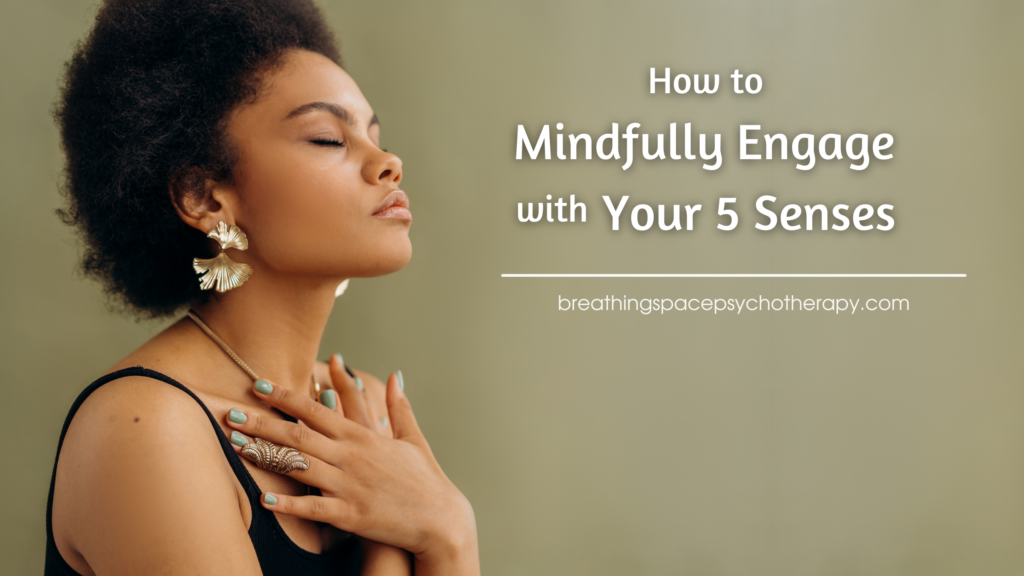Mindful Seeing
Practice mindful seeing by slowing down and describing what you see. Tune into the details of what you’re observing.
- What colors, designs, and patterns do you notice?
- How are things moving, falling, or flowing together?
- How does the light fall or reflect?
- How are the shadows cast?
Ways to embrace your sense of sight for mindfulness:
- Notice the details, colors, objects, lighting, etc. in photos and art around your home or at an art museum;
- Focus on one object in your surroundings and notice its color, shape, texture, and patterns;
- Watch your pet while they rest or play;
- Add a lava lamp to your work or living area;
- Go cloud-watching, bird-watching, or star-gazing;
- Watch the sunset or sunrise;
- Watch the waves move in the ocean;
- Watch how the wind moves flowers, leaves, and your clothes and hair;
- Spend time surrounded by greenery and nature.
Mindful Touching
Practice mindful touching by noticing how objects feel in your hands or against your body. Pick out the details and how you feel.
- What are the texture and weight?
- Is it comfortable, soothing, or unpleasant?
- Is it hot, cold, or somewhere in between?
Ways to embrace your sense of touch for mindfulness:
- Feel your feet on the ground;
- Walk barefoot in the grass;
- Self-massage or use a self-massaging tool;
- Skin-care routine; face masks or foot masks; rub lotion on your hands;
- Cuddle with a pet;
- Put your hands under running water and alternate between warm and cold water every 30-seconds;
- Take a warm bath or go for a swim;
- Stretch or practice yoga poses;
- Notice how your clothing feels on your body;
- Touch the furniture around you and notice the textures;
- Brush a paintbrush over your hands, arms, or legs;
- Play with play-dough or clay;
- Sculpt, make ceramics, finger paint;
- Do hands-on activities such as gardening, knitting, woodworking, baking or cooking, writing by hand, or drawing.
Mindful Hearing
Practice mindful hearing by tuning into the sounds you would normally tune out. Focus on one sound at a time.
- What sounds do you pick up?
- How does the sound travel?
- Can you feel the sound reverberate in your body?
Ways to embrace your sense of hearing for mindfulness:
- Listen to music and pick out the different instruments and elements, such as violins, vocals, or drum beats;
- Sing;
- Read out loud (e.g. a book, this blog post, your writing);
- Listen to guided meditations and chants;
- Play a sound that resonates (e.g. a piano note, a bell) and listen to the sound until it fades out;
- Add a water feature to your work area and listen to the running water;
- Open a window and listen to the nature or city sounds;
- Listen to bird-singing;
- Listen to wind chimes;
- Listen to a metronome.
Mindful Smelling
Practice mindful smelling by noticing the scents around you. Try describing the smells by voicing them out loud or signing to yourself; writing; or telling someone else if you’re doing these activities with others.
- Can you identify the scent?
- How would you describe it?
- How does your body react to the scent (e.g. wrinkling nose, mouth-watering)?
Ways to embrace your sense of smell for mindfulness:
- Carry scented chapstick;
- Cook or bake and smell the ingredients;
- Smell your food during your meal;
- Smell your coffee brew or tea;
- Use a favorite fragrance;
- Burn incense or candles;
- Diffuse scented oil;
- Put fresh flowers and herbs in your home or work area;
- Get scratch-and-sniff stickers to carry with you.
Mindful Tasting
Practice mindful tasting by slowing down and savoring your food while you eat. Hold the food in your mouth and taste without chewing for a few seconds, then chew slowly and swallow.
- What is the texture, flavor, and temperature of the food?
- How would you describe it?
Ways to embrace your sense of taste for mindfulness:
- During your next meal, mindfully eat by noticing the flavors, texture, and temperature of your food;
- Notice the flavors and temperature of your coffee, tea, or other beverage;
- Chew gum;
- Eat a mint;
- Enjoy a “mini buffet” and explore different flavors by finding and mindfully eating something spicy, something bitter, something sweet, something sour, something salty, etc.





